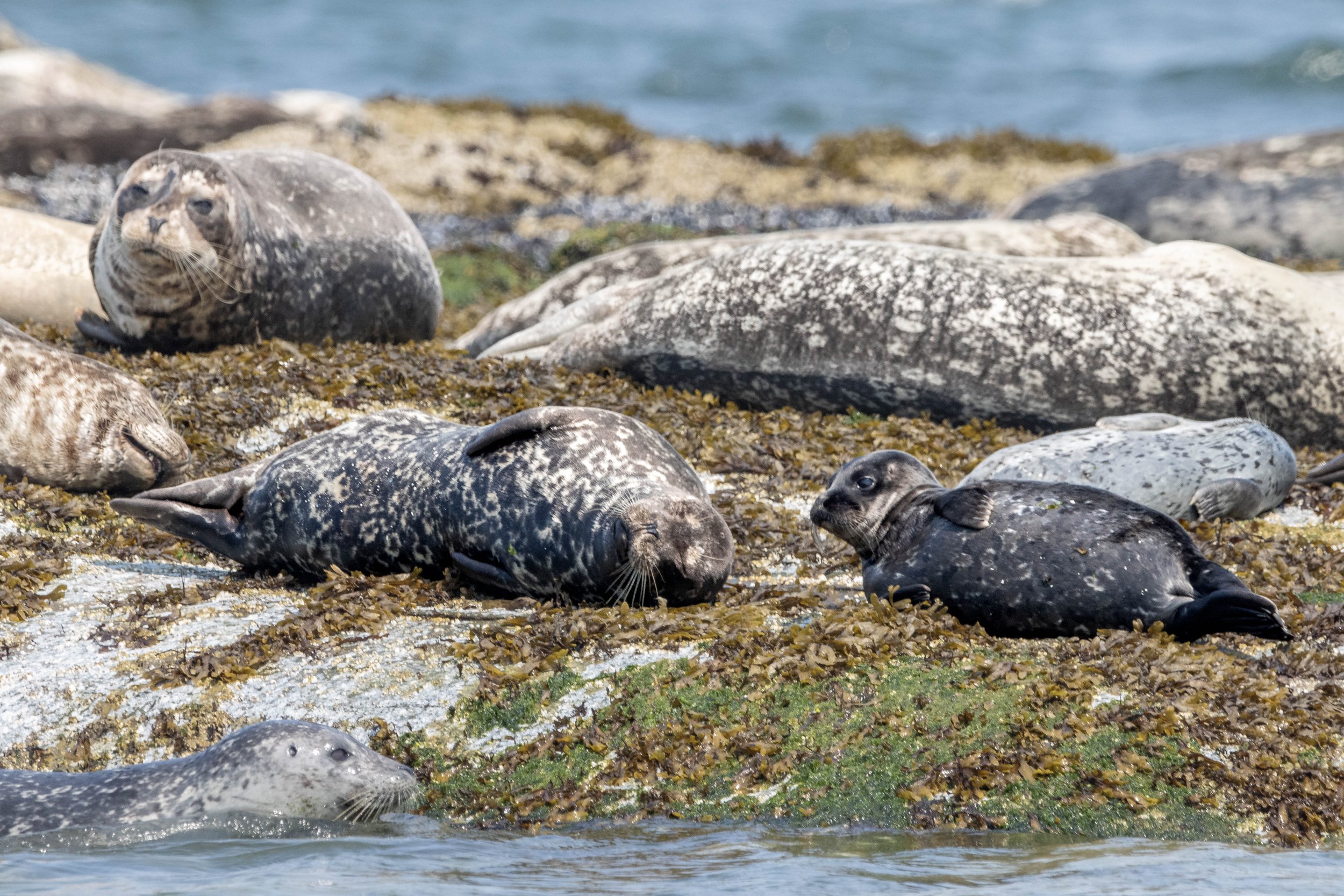August 9, 2024, 10:30 AM - Fin-filled morning with Malachite, Holey Moley, and briefly Kappa
All three of or boats pushed off the dock this morning, eager to get out into what we call “Humpback Land”. Today we were on a waterway known as the Strait of Georgia, which runs from just south of Campbell River to the San Juan Islands. Most of the Strait is between 150-300 meters, but the very middle parts can be up to 400 meters deep! This is an area rich in tiny plants and animals called plankton, little shrimp-looking creatures called krill, and small schooling fish. Humpbacks are usually out here feeding on that!
Today we found Humpback Whales Malachite (KEY0047) and Holey Moley (BCY1198) doing just that… until they had other ideas. Malachite has recently decided that our boats are fun to be around, so he did come and check us out today! He even got Holey Moley to come over and take a look. While he was mostly focused on one of our open, zodiac-style boats Cascadia, he checked out our other zodiac Keta and the semi-covered vessel Kula for a few minutes as well. Holey Moley decided that they didn’t want to continue, so they left Malachite to it. While it’s fun to see a humpback up close, we don’t ever force a close encounter. We have regulations in British Columbia that state we have to stay 100 meters away from humpbacks at all times while we’re watching them. However, humpbacks do not have the same regulations for themselves. The only time they get close to boats is on their terms. If they do get close to our vessels, we go into neutral so our propellors are not spinning, or we shut down completely. Our propellers can be a serious threat to humpbacks if either humans or whale is not careful. Multiple humpbacks have been seriously injured, or even killed by boat propellers. There’s a whale named Hope (BCZ0409 calf 2021) that was hit by a boat, with the front part of her dorsal hump being completely split open. Everyone thought Hope was done for because it looked like it went right through the spine. Low and behold, Hope showed right back up, healed and still going. But the injury is still clearly visible. Hope’s story is nothing short of a miracle! This is why we’re careful around boat-curious humpbacks.
Once Malachite was bored of the boats, he went off into the distance, but he still seemed to have energy. He started throwing his tail up in the air in the humpback version of a cartwheel! Both human and humpback were having such a fun morning, but unfortunately, we had come to the end of our hour with him and had to leave.
On the way to find some other wildlife, our semi-covered vessel found Kappa (BCX0158). Kappa’s first official record was in 1997, but she was possibly seen earlier in 1996. This would technically make Big Mama (BCY0324) not the only humpback to be seen back in our waters after the whaling era. Big Mama definitely could have been seen first, but she wasn’t the only whale here in 1997. The history of whales is sometimes cloudy, and it’s fun to investigate to figure it all out.
On the way back to the dock, we stopped for some wildlife. We try our best every trip to incorporate more than just whales if time allows! We stopped at Stinky Rocks to see some Steller Sea Lions and Harbour Seals and were able to visit the Gabriola Bluffs for the nesting Cormorants. Finally, we entered the harbour after an amazing day on the water.
Photos today were taken by Marine Naturalists Val Watson, Lucy Willis, and Hayleigh Hilbert.
Malachite’s dorsal fin. Photo by Val Watson.
The very white pectoral fin of Malachite. Photo by Val Watson.
Did you know that Malachite’s dorsal fin is 1/3 of his body length. Photo by Val Watson.
Holey Moley lifting their tail. Photo by Val Watson.
A close look at Malachite’s tail. Photo by Val Watson.
Malachite rolling on his side with his pectoral fin in the air. Photo by Val Watson.
Holey Moley’s dorsal fin as they surfaced nearby. Photo by Val Watson.
Holey Moley lifting their pectoral fin. Photo by Val Watson.
Right up (likely) malachite’s blow holes. Photo by Val Watson.
Malachite flicking his tail. Photo by Hayleigh Hilbert.
The underside of Holey Moley’s tail flukes. Photo by Val Watson.
These are Humpback Whale Barnacles on Malachite’s rostrum. Photo by Val Watson.
Malachite lifting his tail during a flick. Photo by Val Watson.
A huge fluke waterfall from Malachite. Photo by Val Watson.
Malachite lifting his tail flukes. Photo by Val Watson.
A beautiful look at Malachite’s tail. Photo by Val Watson.
Malachite doing a mini-cartwheel. Photo by Lucy Willis.
A cartwheel from Malachite. Photo by Hayleigh Hilbert.
Look at how much of Malachite’s body is comin out of the water with this tail slap! Photo by Lucy Willis.
Malachite lifting his tail. Photo by Lucy Willis.
The underside of Kappa’s tail flukes. Photo by Hayleigh Hilbert.
Some Steller Sea Lions on the UM buoy near the Gabriola Reefs. Photo by Lucy Willis.
A big Steller Sea lion sticking their tongue out. Photo by Val Watson.
A cuddle puddle of Steller Sea Lions. Photo by Hayleigh Hilbert.
Look at the claws of this Harbour Seal. Photo by Lucy Willis.
Although it looks like this seal is wearing a mask, its just the oil they secrete to help the see under the water. Photo by Lucy Willis.
Some sleepy Harbour Seals. Photo by Lucy Willis.
Cormorant’s on their nest. Photo by Val Watson.




























